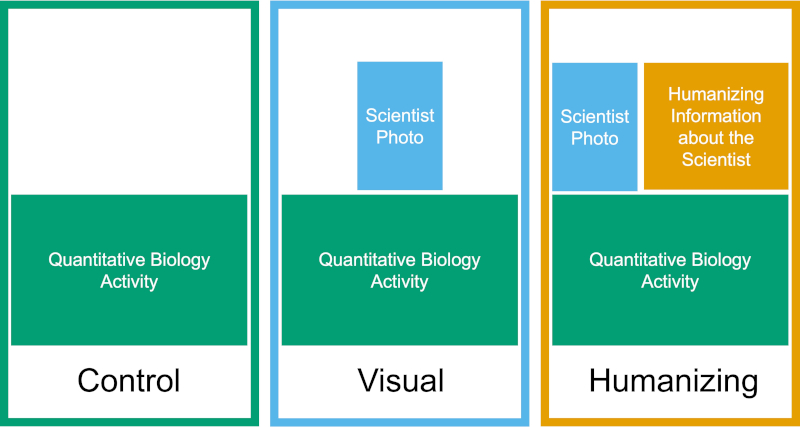When asked to name scientists, students mention the likes of Charles Darwin, Albert Einstein, and Isaac Newton. And when asked to draw a scientist, students almost always draw a white man holding a test tube and wearing a lab coat. Professor Robin Costello from the University at Buffalo tells us more about a new study that parsed the effects of including visual depictions and humanizing information about scientists featured in undergraduate biology course materials.

How students think of scientists reflects the false narrative that only certain types of people can be scientists - specifically white men with brilliant minds.
One powerful tool to combat this false narrative is to feature relatable, contemporary scientists whose identities do not match the dominant stereotype of a scientist featured in course materials. To highlight counter-stereotypical scientists, instructors can implement course materials that include photographs of scientists in their lecture slide decks. Or instructors can highlight humanizing information about scientists in their course materials. Sharing information such as the barriers scientists have faced or how they overcame obstacles in STEM may help students relate to scientists and envision their own STEM careers.
In our latest study, we parsed the effects of including visual depictions and humanizing information about scientists featured in undergraduate biology course materials with a large-scale research study. Over several academic terms and 36 undergraduate institutions in the United States, we distributed three versions of short quantitative activities (Data Nuggets) that varied in their level of information about the featured scientists (from including only their names and pronouns to full Project Biodiversify scientist profiles).
Data from over 3,700 students revealed that including humanizing information about scientists improves student engagement with quantitative biology activities. Photos of the scientists alone were not enough to improve student engagement. Instead, when provided information about the scientists’ life experiences, students found the activities more interesting, more relevant to their future careers, and put more effort into the activities. Our data suggests this pattern was driven by increased relatability of the featured scientists.

While these results applied to all students, the strongest impacts were evident among students who shared excluded identities with the featured scientists.
Our findings underscore the importance of providing students with examples of relatable scientists in STEM courses, rather than simply adding photos to increase representation. By highlighting humanizing information about scientists, instructors can both increase student engagement in their courses and improve equity in STEM.We recommend several evidence-based resources to use in biology courses, including the Data Nuggets and Project Biodiversify materials studied here (together, DataVersify), as well as Scientist Spotlights, BioGrapI, and the Story Collider Podcast.
About the authors
Robin Costello is an assistant professor at the University at Buffalo (SUNY) in the Department of Biological Sciences. She conducts biology education research that evaluates scalable pedagogical approaches aimed at promoting equitable student outcomes in undergraduate biology courses.
Emily Driessen is a postdoctoral researcher at the University of Minnesota. The overarching goal of her research is to enhance student learning and retention in undergraduate biology courses through the use of active learning strategies and curricula alterations.
Melissa Kjelvik is a co-founder of the Data Nuggets program, a program coordinator for a marine natural resources training program, and a senior research specialist at Michigan State University. Melissa merges her formal training in ecology with her experience in science education to bring contemporary research and role models into K-16 classrooms.
Elizabeth Schultheis is co-founder of Data Nuggets and the Education & Outreach Coordinator for the Long Term Ecological Research Program at the Kellogg Biological Station. Elizabeth helps scientists share their stories and research with broad audiences to promote scientific and data literacy.
Rachel Youngblood recently graduated from Auburn University with a B.S. in Exercise Science. At Auburn, she was an undergraduate research fellow in the Ballen Lab, where her research focused on diversity and representation in biology education. Currently, she is pursuing her master’s in special education.
Ash Zemenick is the co-founder of Project Biodiversify, a group dedicated to increasing diversity, equity, and inclusivity of biology classrooms.
Marjorie Weber is an associate professor at the University of Michigan in the Ecology and Evolutionary Biology Department and co-founder of Project Biodiversify.
Cissy Ballen is an associate professor at Auburn University in the Department of Biological Sciences. As a discipline-based education researcher, Cissy directs multiple biology education reform efforts and is deeply engaged in the study of what makes role models effective.
What was your experience like publishing in Proceedings B?Publishing in Proceedings B was a great experience with clear communication and excellent reviewer comments that both improved our manuscript and changed our thinking. Publishing our work as a Biological Science Practices article provides the opportunity for our biology education research to reach a wide biology readership, which is important for spreading this message of how to represent counter-stereotypical scientists in biology courses.
Proceedings B is looking to publish more high-quality research articles, biological science practices articles and reviews. If you have an idea for a review, we strongly encourage you to submit a proposal by completing our proposal template and sending it to the journal. More information about the journal and the submission process can be found on our website.
Image credits:
Image 1: Mike Costelloe.
Image 2: Diagram of the three different treatments, Robin Costello.


